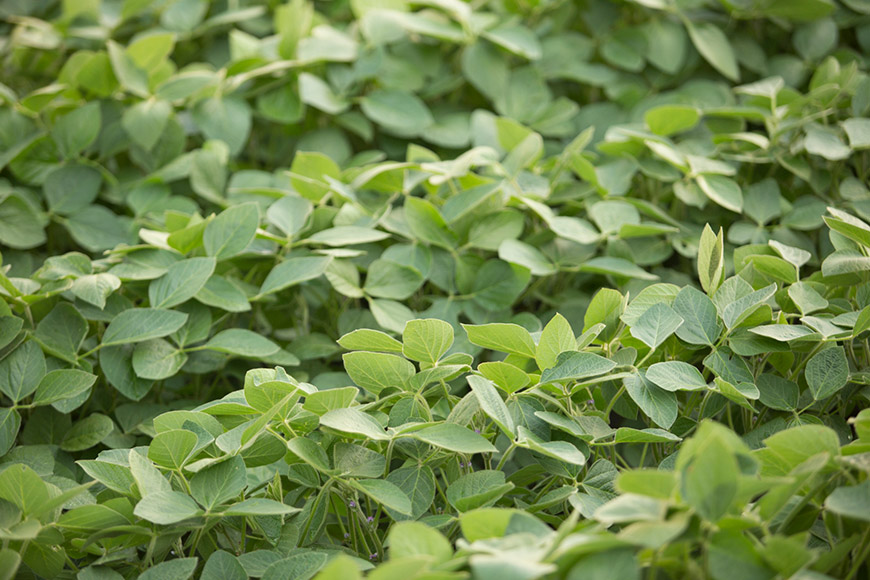Dicamba 101: Questions From the Field

Dicamba label restrictions have been updated once again for the 2021 season, and it’s important to know what those updates mean for your operation. Here are answers to some of the most common dicamba questions I’ve been hearing in the field.
What’s the difference between 2,4-D and dicamba?
Dicamba and 2,4-D are both Group 4 herbicides with the same mode of action. Both herbicides are growth regulators, but they cannot be used interchangeably in-season over crops. The technology that makes each crop tolerant to 2,4-D or dicamba is specific for each of those herbicides. Applying dicamba on 2,4-D tolerant crops will damage or kill them and vice versa. Label requirements, including application rates and plant-back restrictions, are also different for each herbicide. Always consult the label for the herbicide product you plan to use to be sure you’re following all requirements.
How can I differentiate between 2,4-D and dicamba damage in soybeans?
Dicamba and 2,4-D can both damage sensitive crops. Research shows that just 1/20,000 of a labeled rate of dicamba can cause cupping in non-tolerant soybeans. We’re still learning about 2,4-D sensitivity in soybeans, but it appears they are more sensitive to dicamba than 2,4-D. The extent of herbicide damage depends on a variety of factors, including the timing of the application and the rate of herbicide applied. Yield loss is more likely if herbicide damage occurs during reproductive growth stages. In that case, pods could be aborted or damaged. Visual symptoms of dicamba damage include leaf cupping, and 2,4-D damage in soybeans can result in leaf drooping, leaf strapping, elongated leaves, stem twisting and stem callouses.
What is a drift-reduction agent and is it necessary?
All dicamba herbicides must now be applied with a drift-reduction agent (DRA). OnTarget® adjuvant is a specifically formulated DRA for ultra- and extra-coarse nozzles used in dicamba applications and can reduce driftable fine spray particles by up to 50%.1 It is designed to improve overall weed control by helping with droplet spreading and canopy deposition.
Is a DRA enough to adequately control dicamba drift?
Studies done at the WinField United Innovation Center indicate that adding specific adjuvants in addition to DRAs can reduce the number of small droplets in a spray solution even more than using a DRA alone. InterLock® adjuvant is a drift and deposition aid that can help further reduce the number of driftable fine droplets, and it improves spray deposition into the crop’s canopy. Adding InterLock to OnTarget in the spray tank along with a water conditioner can reduce driftable fines by 60%.1 The relative cost of using both products in the tank mix is much less than the cost of the dicamba herbicide, so it’s a good investment to ensure you’re getting the most from your herbicide application.
Why should I be concerned about the pH of my dicamba tank mix?
The label for low-volatility dicamba products suggest that applicators test tank-mix pH to ensure it remains above 5.0. Research has shown that adding glyphosate with dicamba in a tank mix can lower the pH of the solution, which creates an acid that can increase the risk of volatility when the spray is applied. This can be addressed with a volatility reduction agent (VRA), such as Volt-Edge™, a VaporGrip® Xtra Agent. VRAs help reduce dicamba volatility and are part of the label requirements for many dicamba registrations.
What if my dicamba-tolerant soybeans are planted late? What does that mean for in-season dicamba applications?
This year in most regions, planting is off to a good start. However, when soybean planting gets delayed, it can cause some logistical challenges for getting in-season dicamba applied in accordance with label requirements. For the first time this year, the EPA established two federal cutoff dates for dicamba applications, including a June 30 cutoff for soybeans and a July 30 cutoff for cotton, while some states have set even more restrictive dates.
That said, it’s critical for farmers to have a contingency plan for weed control on Roundup Ready 2 Xtend® soybean acres. Even if soybeans are planted on time, the strict restrictions based on environmental conditions and time of application can impose logistical constraints that may make it difficult to get acres covered. It’s always good to have a Plan B if you’re intending to spray dicamba in-season.
A strong pre-emergence program that includes low-volatility dicamba plus a Group 14 or 15 soil-residual herbicide with metribuzin can help keep fields clean until you can get in with a postemergence application. There are no plant-back restrictions when low-volatility formulations of dicamba are applied as a burndown ahead of planting Roundup Ready 2 Xtend soybeans. Work with your local agronomist for postemergence herbicide options if you’re unable to apply dicamba in-season.
What label requirements could affect me most?
Good recordkeeping is crucial. The federal label requires records to be completed within 72 hours of a dicamba application, and some states require reporting even sooner. Recording weather conditions and clean-out procedures are important in the event there are questions about dicamba applications in the future.
The federal label mandates sprayer system clean-out before and after dicamba applications. Review specific label requirements for approved clean-out procedures. Remember, only certified applicators are permitted to apply low-volatility dicamba products, and they must be trained annually.
Get answers before you apply
As we’ve seen over the past several years, there are risks involved with spraying dicamba. Be sure you understand updated label restrictions before applying dicamba. Reach out to your local WinField United retailer for additional clarification and recommendations.
1Based on WinField United Innovation Center spray analysis data.
This article was originally published in March 2020 and was updated in May 2021.
All photos are either the property of WinField United or used with permission.
© 2021 WinField United. Important: Before use always read and follow label instructions. Crop performance is dependent on several factors many of which are beyond the control of WinField United, including without limitation, soil type, pest pressures, agronomic practices, and weather conditions. Growers are encouraged to consider data from multiple locations, over multiple years, and to be mindful of how such agronomic conditions could impact results. MAX-IN®, OnTarget®, InterLock® and WinField® are trademarks of WinField United. Roundup Ready 2 Xtend® is a trademark used under license from Bayer CropScience.


